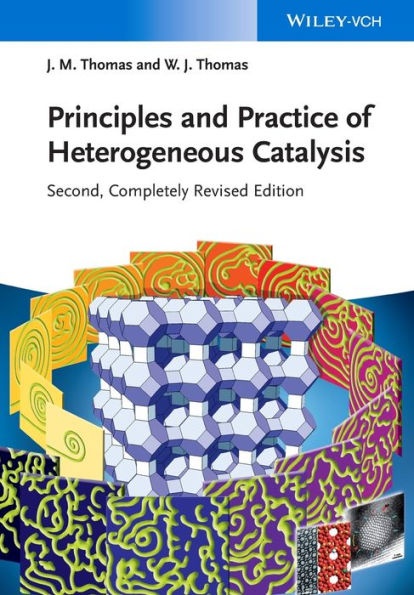Table of Contents
Preface XIX
1 Setting the Scene 1
1.1 Prologue: Advances since the Early 1990s 1
1.2 Introduction 13
1.3 Perspectives in Catalysis: Past, Present and Future 16
1.4 Definition of Catalytic Activity 32
1.5 Key Advances in Recent Theoretical Treatments: Universability in Heterogeneous Catalysis 52
1.6 Milestones Reached in Industrial Catalysis in the Twentieth Century, and Some Consequential Challenges 54
Problems 61
References 64
Further Reading 66
2 The Fundamentals of Adsorption: Structural and Dynamical Considerations, Isotherms and Energetics 67
2.1 Catalysis Must Always Be Preceded by Adsorption 67
2.2 The Surfaces of Clean Solids are Sometimes Reconstructed 71
2.3 There Are Many Well-Defined Kinds of Ordered Adlayers 74
2.4 Adsorption Isotherms and Isobars 79
2.5 Dynamical Considerations 86
2.6 Relating the Activation Energy to the Energy of Chemisorption. Universality in Heterogeneous Catalysis and the Brønsted–Evans–Polanyi (BEP) Relation 101
2.7 Deriving Adsorption Isotherms from Kinetic Principles 105
2.8 Energetics of Adsorption 113
2.9 Mobility at Surfaces 126
2.10 Kinetics of Surface Reactions 127
2.11 Autocatalytic, Oscillatory and Complex Heterogeneous Reactions 132
2.12 Microkinetics: A Summary 147
Problems 155
References 161
Further Reading 162
3 The Characterization of Industrial and Model Solid Catalysts 163
Part I: Characterization of Industrial Solid Catalysts 163
3.1 Non-invasive Methods Suitable for Studies Involving Catalytic Reactors 164
Part II: Laboratory Characterization of Solid Catalysts 172
3.2 A Portfolio of Modern Methods: Introducing the Acronyms 172
3.3 Which Elements and Which Phases Are Present? 175
3.4 Probing Surfaces with IR, HREELS, AES and XPS 184
3.5 Ultraviolet–Visible and Photoluminescence Spectroscopy 191
3.6 Structure and Crystallography of Surfaces: Nature of Ordered and Reconstructed Surfaces 193
3.7 Other Structural Techniques for Characterizing Bulk and Surfaces of Catalysts 214
3.8 A Miscellany of Other Procedures 258
3.9 Determining the Strength of Surface Bonds: Thermal and Other Temperature-Programmed Methods 259
3.10 Reflections on the Current Scene Pertaining In situ Methods of Studying Catalysts 265
Problems 281
References 288
Further Reading 291
General 291
Additional 291
In situ Techniques 291
4 Porous Catalysts: Their Nature and Importance 293
4.1 Definitions and Introduction 293
4.2 Determination of Surface Area 296
4.3 Mercury Porosimetry 306
4.4 Wheeler’s Semi-empirical Pore Model 308
4.5 Diffusion in Porous Catalysts 314
4.6 Chemical Reaction in Porous Catalyst Pellets 319
Problems 337
References 340
Further Reading 341
Specific Books 342
General 342
5 Solid State Chemical Aspects of Heterogeneous Catalysts 343
5.1 Recent Advances in Our Knowledge of Some Metal Catalysts: In Their Extended, Cluster or Nanoparticle States 345
5.2 Comments on the Catalytic Behaviour of Nanogold 352
5.3 Recent Advances in the Elucidation of Certain Metal-Oxide Catalysts 359
5.4 Atomic-Scale Edge Structures in Industrial-Style MoS2 Nanocatalysts 363
5.5 Open-Structure Catalysts: from 2D to 3D 364
5.6 Computational Approaches 376
5.7 A Chemist’s Guide to the Electronic Structure of Solids and Their Surfaces 389
5.8 Key Advances in Recent Theoretical Treatments of Heterogeneous Catalysis 415
5.9 Selected Applications of DFT to Catalysis 419
5.10 Concluding Remarks Concerning DFT Calculations in
Heterogeneous Catalysis 429
Problems 430
References 433
Key References Published Since the First Edition 436
Seminal Books 436
Monographs 437
Book Chapters 437
Further Reading 437
6 Poisoning, Promotion, Deactivation and Selectivity of Catalysts 439
6.1 Background 439
6.2 Catalyst Deactivation 452
6.3 Some Modern Theories of Poisoning and Promotion 463
Problems 474
References 477
Further Reading 477
General 477
Studies of Model Surfaces 477
Theory of Poisoning and Promotion 478
7 Catalytic Process Engineering 479
Part I: Recent Advances in Reactor Design 479
7.1 Novel Operating Strategies 482
Part II: Traditional Methods of Catalytic Process Engineering 499
7.2 Traditional Catalytic Reactors 499
Problems 534
References 538
General References for Part II 539
General 539
Kinetic Models 539
Experimental Chemical Reactor Configurations 540
Slurry Reactors 540
Further Reading 540
8 Heterogeneous Catalysis: Examples, Case Histories and Current Trends 541
8.1 Synthesis of Methanol 541
8.2 Fischer–Tropsch Catalysis 546
8.3 Synthesis of Ammonia 568
8.4 Oxidation of Ammonia: Stepping Toward the Fertilizer Industry 588
8.5 In situ Catalytic Reaction and Separation 592
8.6 Automobile Exhaust Catalysts and the Catalytic Monolith 601
8.7 Photocatalytic Breakdown of Water and the Harnessing of Solar Energy 614
8.8 Catalytic Processes in the Petroleum Industry 629
Problems 645
References 651
Further Reading 653
9 Powering the Planet in a Sustainable Manner: Some of Tomorrow’s Catalysts (Actual and Desired) and Key Catalytic Features Pertaining to Renewable Feedstocks, Green Chemistry and Clean Technology 655
9.1 Introduction 655
Part I: Prospects, Practices and Principles of Generating Solar Fuels 658
9.2 Powering the Planet with Solar Fuel 658
9.3 Some Significant Advances in Photo-Assisted Water Splitting and Allied Phenomena 659
9.4 The Hydrogen Economy 677
9.4.1 The Methanol Economy 682
Part II: Current Practices in Powering the Planet and Producing Chemicals 685
9.5 Some of Tomorrow’s Catalysts: Actual and Desired 685
9.6 A Biorefinery Capable of Producing Transportation Fuels and Commodity Chemicals that Starts with Metabolic Engineering and Ends with Inorganic Solid Catalysts 707
9.7 Non-enzymatic Catalytic Processing of Biomass-Derived Raw Materials to Selected Chemical Products 711
9.8 Strategies for the Design of New Catalysts 719
Part III: Thermochemical Cycles and High-Flux, Solar-Driven Conversions 724
9.9 Solar-Driven, Catalysed Thermochemical Reactions as Alternatives to Fossil-Fuel-Based Energy and Chemical Economies 724
Acknowledgements 726
Problems 726
References 729
Further Reading 732
Index 733



